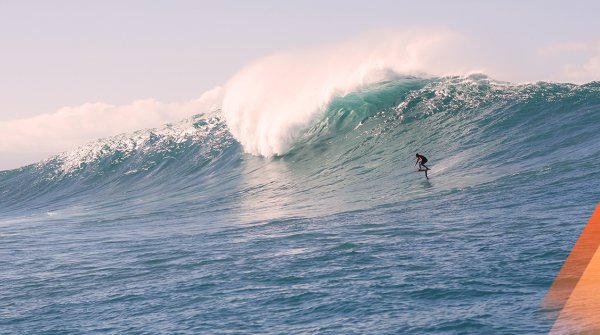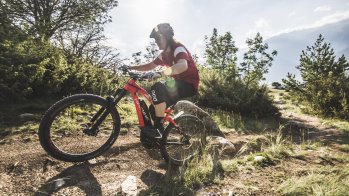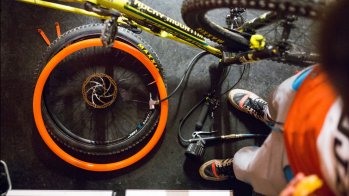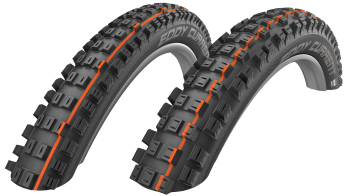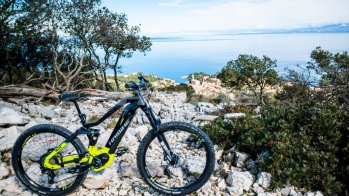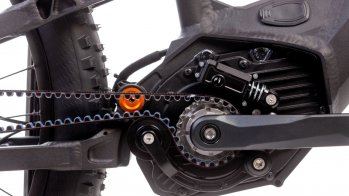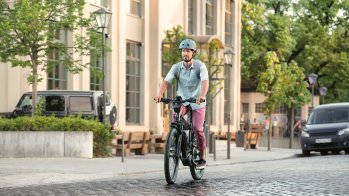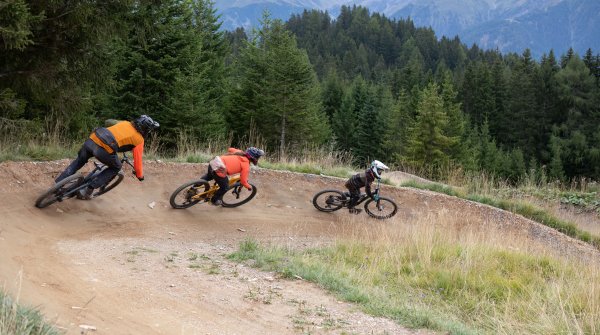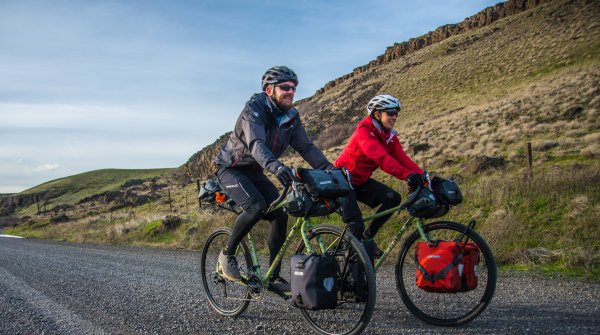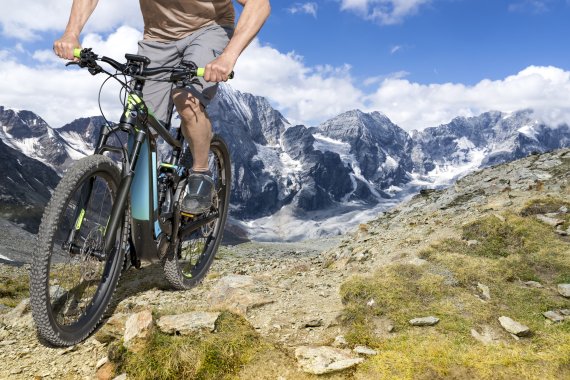
Which sentence seems more correct:
- "With an e-mountain bike, I can get to places I wouldn't go with a normal MTB."
- "With a mountain bike, I can get to places I couldn't get to with an eMTB."
Anyone who has not yet gained any experience with eMTBs probably says: There is more truth in sentence 1. But experienced e-Mountainbikers know: Sentence 2 can be at least just as correct.
In our list of the most important advantages and disadvantages of e-mountainbikes we show how this change of mind comes about.
What could be nicer than doing sports together? Before the age of eMTBs, however, it was mainly homogeneous groups on mountain bikes that were seen in the mountains. Similar fitness level, often similar age. Logical: How is the 65-year-old father supposed to climb the same steep ramps as his trained 33-year-old son? (Yes, of course there are also very fit seniors.)
One of the biggest advantages of e-mountainbikes is therefore that they help to overcome performance differences. No one with a lack of fitness has to feel excluded, thanks to the electric support, a bike trip to the mountains is a pleasure for everyone.
When mountain biking, you quickly run out of breath. This is even the case for trained athletes who don't normally ride MTB. With a bright red head and just below the maximum heart rate you work your way up the mountains and especially the steep ramps. The body works fully anaerobic. These load peaks cost a lot of grains - and that is not necessarily the goal of MTB tours lasting several hours.
Healthier and more effective for fat burning is aerobic training, i.e. a permanent, even load. The e-Mountainbike is the perfect helper for load control. Load peaks are avoided, the pulse is at a pleasant 120 to 140 heart beats per minute. And if you want to get your pump up to speed in between, you can simply switch off the engine for a moment.
E-Mountainbike trends 2018/2019 in pictures
Okay, this advantage comes as no surprise. It is also nice when you arrive at the top of the mountain with your bike without being completely sweaty. But what is really pleasant in practice: With an electric mountain bike you can also master small blockages or root passages uphill where you get stuck with a mountain bike.Another small advantage: starting up on a steep slope is effortless with an eMTB.
E-Enduros, which make their drivers independent of lifts, are currently very much in vogue. So you can ride ingenious trails several times a day. Uphill driving is often carried out with maximum E support. E-Enduro bikers like to store spare batteries so that the end (in the) terrain is not quickly reached during these battery energy-sapping rides.
And even downhill e-mountain bikes can be a lot of fun. At least this was the case with our test bike, the Strike eRide 720 from Scott. Because especially in rough terrain you feel safe on a massive eMTB. Especially since the centre of gravity is much lower in the crank due to the electric motor.We will discuss the disadvantages in technical passages later.
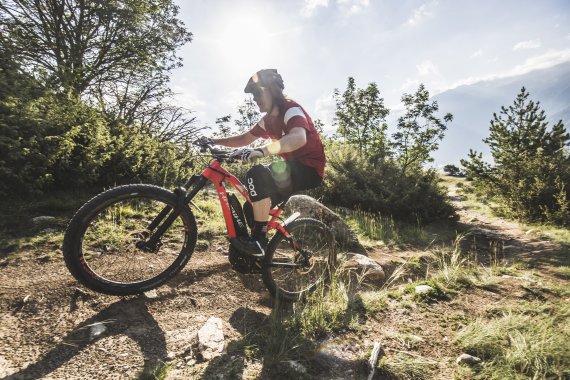
As an e-Mountainbiker in a group of "normal" bikers you should fit into this role: that you like to be misused as a load donkey for spare hoses, tools and emergency set. What is the advantage? Well, on the other hand, it is also easier to take the camera equipment into the mountains with you that you would never have carried up with you in the past.
In addition, on an eMTB it doesn't hurt so much if you took a wrong turn at the last turn-off and now have to go back 100 meters in altitude. (Who doesn't know that?) And in an emergency it is sometimes possible to get help faster with an e-Mountainbike.
If you like to try out new sports equipment, you can't avoid an electric mountain bike. It doesn't have to be a purchase right away. eMTBs make it possible to experience things you're not used to: speeding up the gravel road at 20 km/h. Just trample up the steepest slope in town. End the 75-kilometer tour with the 2,500 meters of altitude without aching legs. In short: e-mountainbiking is really fun.
Getting a convinced mountain biker to switch to the eMTB is sometimes not that easy. And in fact the disadvantages of e-mountainbikes cannot be denied.
If you want to buy an electric mountain bike, you have to dig deep into your pocket. Even the price for entry-level models is over 2,000 euros - if you have a certain demand for quality. For this price you get for example the Haibike SDURO HardSeven 1.0.
Our test bike from Scott with its 6.000 Euro is not even in the highest price range. For the Haibike Flyon NDURO you get around 9,000 euros off - and ultimately it's no problem to pay a five-figure amount for e-Mountainbikes.
So could it be a good alternative to borrow the eMTB? Yeah, but it's not cheap either. Depending on model and season you pay between 40 and 70 Euro per day.
When you sit on an electric mountain bike, its weight doesn't play a big role. But it gets exciting when you have to dismount. Anyone who finds it annoying to carry a mountain bike (usually weighs about 10 to 14 kilos) up a short passage or load it into a car will curse an electric mountain bike. Because eMTBs weigh 25 kilos, even if you take out the battery, it's only 2.5 to 4 kilos less.
Tip on the side: The battery should always be removed and safely stowed before transporting the bike by car.
Some tours are impossible for E-Mountainbiker. You have to be very strong to be able to climb safely over stones or over a flooded, blocked path with an eMTB on your shoulder. The often built-in so-called pushing aid does not help here either.
As a mountain friend, who had borrowed an eMTB for testing purposes, put it so nicely: "It's like driving a moped in the mountains". In fact, a normal mountain bike is much easier to steer in technical passages.
If the battery is installed in the down tube in such a way that it is much wider (as with our test bike from Scott), the turning circle of the e-mountainbikes also increases, the handlebar cannot be turned so far. With an eMTB, sharp hairpin bends that allow you to manoeuvre a normal MTB without any problems, even as an inexperienced rider, require maximum concentration - if you don't even have to descend and lift for a short time. A displacement of the rear wheel from the wheel is already with a (easier) normal MTB a technique for advanced and becomes even more difficult with the eMTB.
No, as an e-mountainbiker you are not welcome everywhere. Many mountain bikers and hikers react to motorization with blatant rejection. Your sensation: Those who cannot make it into the mountains with their own strength have no business there.
The times in which eMTBs were at least admired as a technical innovation are over. In many places, mountain sports enthusiasts feel massively disturbed by e-mountain bikers - and express this clearly. This also varies from region to region. The only thing that helps here is tolerance, friendliness and consideration.
What does it mean for the range, if the battery of the e-mountainbikes has a capacity of 500 Watt hours? Compared to normal e-bikes or pedelecs, the range calculation for eMTBs is much more difficult. Because the mountain factor brings another variable into play.
Nothing is more annoying than a rechargeable battery that will fail before the end of the tour. Most eMTBs are extremely difficult to handle without electrical support. Not only because of the increased weight of the bike, but also because a clear pedaling resistance can be felt with many drives (for example, with the often installed Bosch Performance CX electric motor). However, the latest generation of drives does not require pedal resistance.
Back to the initial question: 500 watt hours of battery capacity simply means that you could drive at full throttle for two hours with a 250 watt motor. That can only be 30 kilometres in steep terrain - or even 150 kilometres in the plain.
If you want to use the E-Power on the mountain, you first have to charge it into the battery - that's clear. Actually not a big deal, but also a task you have to take care of: Remove battery, plug in power adapter, connect to battery, wait a few hours, unplug, install battery.
Doof: Some batteries cannot be removed (e.g. Rocky Mountain Instinct Powerplay). If you don't want to take your bike with you, you have to improvise here.
Which you shouldn't forget: Lithium-ion batteries have a limited service life. Depending on load and storage, eMTB rechargeable batteries can last around 500 charging cycles before they have to be replaced. And that's expensive: The Bosch Powertube 500 battery installed in our Scott test bike costs around 650 euros.
By the way, the electricity costs for charging do not belong on this list of disadvantages, they are too marginal for that. A battery charge for our test bike (battery capacity 500 Wh) does not even cost 15 cents.
The individual components of eMTBs wear out faster because they are usually not specially designed for e-mountainbikes. The high weight has a negative effect on brake pads and brake discs, while the additional forces of the electric motor reduce the service life of the chain, chainring and cassette.
If some parts of an electric mountain bike have to be replaced after just a few months, this may also be due to the human component: studies have shown that an electric bike is used much more frequently and rides more kilometres than a normal bike.
In addition, the maintenance of an eMTB is more time-consuming - and therefore more expensive. An e-mountainbike service in a specialist workshop costs between 50 and 100 Euro.
ebike-mtb.com has calculated exactly and has come up with maintenance costs of 590 euros for a mileage of 3,500 kilometres.
In our list of e-mountainbikes, six advantages are compared to a total of seven disadvantages. Of course, this does not mean that the disadvantages outweigh the disadvantages. After all, everyone has to decide for himself how he weights the pros and cons. Anyone who feels great pleasure driving an eMTB should not be afraid of the high costs.
Our tip: If an E-Mountainbike is the right thing for you, you should try it yourself. It's best to borrow an eMTB from a specialist dealer or use bike festivals and test days to form your own opinion.
In your opinion, have we forgotten an important advantage or disadvantage? What is your opinion about e-mountainbikes? Leave us a comment!
- ISPO awards
- Mountain sports
- Bike
- Design
- Retail
- Fitness
- Health
- ISPO Job Market
- ISPO Munich
- ISPO Shanghai
- Running
- Brands
- Sustainability
- Olympia
- OutDoor
- Promotion
- Sports Business
- ISPO Textrends
- Triathlon
- Water sports
- Winter sports
- eSports
- SportsTech
- OutDoor by ISPO
- Heroes
- Transformation
- Sport Fashion
- Urban Culture
- Challenges of a CEO
- Trade fairs
- Sports
- Find the Balance
- Product reviews
- Newsletter Exclusive Area
- Magazine

